Daily News
by Gail Helmer
[ Send Us News | Archives ]
10 New Screens: Lock On: Modern Air Combat
Ubi Soft has sent us a 10 new screenshots from Lock On: Modern Air Combat, Ubi Soft's highly-anticipated jet combat flight simulation, expected to ship in the first quarter of 2003.
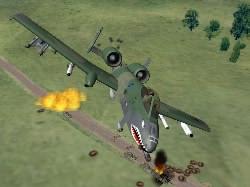
Lock On: Modern Air Combat features nine different flyable Russian and U.S. Air Force combat jets including the F-15C "Eagle", the A-10A "Thunderbolt II", the Su-27 "Flanker B", the Su-33 "Flanker D", the MiG-29S "Fulcrum", the MiG-29A "Fulcrum" (both Russian and German versions), the Su-25 "Frogfoot" and the Su-39 "Frogfoot". These aircraft encompass an array of both air-to-air and air-to-ground combat aircraft for both US and Russian forces and will allow players a broad-range of combat missions.
Lock On also features:
GMX Media today announced its second title set for release this year. Napoleon is a Real-Time Strategy game based on the battles that took place between 1803-1812.
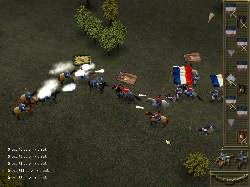
The game allows players to simulate Napoleon's historical battles on a large scale. With realistic special effects that simulate weapons and battle sequences, realistic physics and an unprecedented attention to detail, Napoleon is set to take Europe by storm. The title is set for release on October 25th 2002. Screenshots
New Screens: Cossacks - Back to War
We have 9 new screens from the second official expansion to Cossacks - European Wars. Cossacks - Back to War features 100 new single missions, 2 new nations: Switzerland and Hungary, and up to 8000 units on a map.
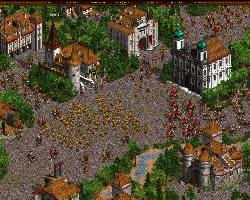
Military News
Aviators Rescued Following Tomcat Crash
Two crewmen were rescued yesterday (July 8) after their F-14 "Tomcat" crashed off the Virginia Capes. The aircraft was from Fighter Squadron 101 (VF 101) based at NAS Oceana.
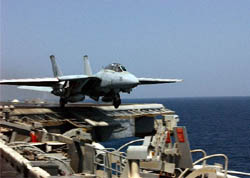
The two-man crew, an instructor pilot and a replacement pilot, successfully ejected from the aircraft and were rescued by a U.S. Coast Guard "Jayhawk" helicopter from the Coast Guard Air Station at Elizabeth City.
They were transported to Naval Medical Center Portsmouth where they are reported in good condition. A thorough medical evaluation is being conducted.
The aircraft was on a routine training mission when the accident happened.
The cause of the accident is under investigation.
Indian Head Testing Paves Way for Tactical Tomahawk
Tactical Tomahawk, the next generation of the Navy’s Tomahawk cruise missile, underwent a successful functional ground test (FGT) recently at IHDIV’s Rocket Motor Test Facility.
This test served as a risk mitigation event prior to the first Tactical Tomahawk flight test. The successful completion of this test is a major milestone in the development of this new Tomahawk variant. The Tactical Tomahawk cruise missile is being developed for the Navy by Raytheon Systems Company.
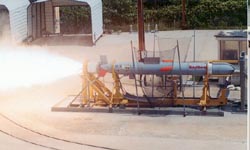
During this low-risk, high-fidelity test, the missile is exercised at the system level as it would be in free flight except that the missile is restrained in a specially designed test stand. A real time, six-degree-of-freedom simulation, developed by Raytheon and integrated into the FGT test platform by Indian Head engineers, was used to provide inputs to the missile’s guidance system to simulate actual flight. Data review indicates that this missile design demonstrated all critical flight events required to achieve a successful flight.
Following the successful test, Troy Goertz, Raytheon lead engineer, acknowledged, "There is no substitute for system level testing." Additionally, Cmdr. Mat Winter from the PMA-280 program office stated, "Once again FGT has demonstrated value added to the [Tomahawk Cruise Missile] program."
The initial Functional Ground Test evolutions on 5 February and 30 April 2002 at IHDIV were successful in flushing out a handful of anomalous behavior within the missile design. Due to the realistic and thorough nature of the FGT execution, design inadequacies within the propulsion, fuel and avionics sub-systems were identified. The design teams were able to identify root cause and efficiently implement re-design efforts to satisfactorily resolve the identified inadequacies. The final "go-fly" design configuration was successfully demonstrated during the latest FGT.
The FGT program at Indian Head began in 1990 as a basic test capability in support of the Cruise Missile Office, PMA-280. Over the last 12 years, 60 missile tests have been conducted at the test facility. The Tomahawk cruise missile evolved during the ‘90’s with upgrades in hardware and software, such as the addition of the global positioning system (GPS) to the guidance system, and continues to evolve.
This next-generation Tactical Tomahawk includes many improvements, including launch platform mission planning capability; in-flight retargeting, loiter, battle damage assessment capability; and in-flight health and status reporting (the ability to communicate with the missile during flight is accomplished through a satellite data link).
With every upgrade or enhancement to the missile system, IHDIV’s FGT experts must also evolve and upgrade the test platform to exercise all missile subsystems during the ground test.
The FGT team worked for over two years preparing for the first FGT of the Tactical Tomahawk variant. Design advancements required several upgrades to the FGT platform including test stand redesign, Tactical Tomahawk hardware-in-the-loop (HWIL) development, six-degree-of-freedom simulation rehost, interface hardware/software upgrades, telemetry upgrades, GPS satellite simulator upgrade, and updating of the variable radar altimeter test set.
All platform upgrades required extensive testing using the HWIL and an inert operational missile to demonstrate test capability prior to the actual FGT. The FGT team, working with RSC, completed all upgrades to the test platform on schedule and within budget.
In addition to establishing the capability to test the Tactical Tomahawk variant, several logistical “firsts” were achieved. IHDIV was the first Navy activity to take receipt of and handle the Tactical Tomahawk. New handling procedures were required and developed by IHDIV engineers working with IHDIV’s PHS&T Center and Raytheon personnel.
Also, after receiving the test missile from Raytheon, IHDIV was the first Navy activity to perform a "decan" procedure, which removes the weapon from the Ml 10 launcher tube.
The Tactical Tomahawk (Block IV) is the next generation of the Navy's premiere cruise missile, due to reach the fleet in 2004, and will supplement the current Tomahawk Block II/III inventories. The Tomahawk is launched from surface ships and submarines and was first employed operationally during Desert Storm. Since then, the missile has been heralded for its accuracy and lethality.
As the weapon continues to evolve, IHDIV responds and provides the Tomahawk program with a low-risk, high-fidelity test capability. The Tomahawk program is managed by the Program Executive Officer, Strike Weapons and Unmanned Aviation (PEO(W)).
Officials Release RQ-4A Accident Report
Air Force investigators have determined structural failure caused an Air Force RQ-4A Global Hawk aircraft to crash Dec. 30 at a deployed location supporting Operation Enduring Freedom.
The Global Hawk, an unmanned reconnaissance aircraft, was destroyed upon impact about 80 miles from its operating location. No one was injured in the accident. The aircraft was assigned to the 12th Expeditionary Reconnaissance Squadron, but its parent unit is the 9th Reconnaissance Wing at Beale Air Force Base, Calif.
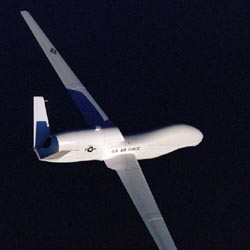
According to an Air Combat Command Accident Investigation Report, the primary cause of the accident was the structural failure of the right V-tail and ruddervator assembly because of massive delamination of the main spar. This was the result of the failure of a control rod which was bent by coming in contact with an improperly installed actuator nut plate bolt.
The ruddervator, which is a combination of a rudder and elevator, provides directional flight control for the aircraft. After the control rod failed, the aircraft entered a right spin and hit the ground. (Courtesy of ACC News Service)
Dodge Viper Takes on Air Force F-16
In what can only be called a Barnum and Bailey type marketing ploy, DaimlerChrysler, as a segment for "Ripley's Believe It Or Not!", pitted its all-new Dodge Viper against an F-16 jet in a side-by-side, standing-start, half-mile drag race on parallel air base runways, accelerating to the speed at which the jet became airborne: approximately 150 mph. The Dodge Viper covered the course in around 15 seconds.
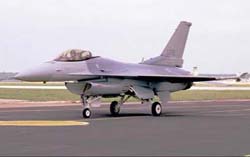
The event featured two battles with pre-production versions of the 2003 Dodge Viper SRT-10 convertible challenging the Lockheed Martin F-16 Fighting Falcon, and two more with a prototype 2003 Dodge Viper Competition Coupe against another F-16 Viper. For the latter, DaimlerChrysler's PVO team tapped more horsepower and clad their Viper in racing slicks, while the USAF countered with takeoff runs at full afterburner.
While the F-16 boasts approximately 25,000 pounds of thrust in a compact, 19,000-pound package capable of more than 1,500 mph, the Dodge Viper showcases 525 pound-feet of torque, a 3,380-pound curb weight and estimated 190 mph top speed.
Segment to Air on Ripley's 'Believe it or Not!' on July 10th at 8 p.m. EDT
[ Send Us News | Archives ]
by Gail Helmer
Tuesday July 9, 2002
- 10 New Screens: Lock On: Modern Air Combat
- Another Napoleon RTS
- New Screens: Cossacks - Back to War
- Aviators Rescued Following Tomcat Crash
- Indian Head Testing Paves Way for Tactical Tomahawk
- Officials Release RQ-4A Accident Report
- Dodge Viper Takes on Air Force F-16
10 New Screens: Lock On: Modern Air Combat
Ubi Soft has sent us a 10 new screenshots from Lock On: Modern Air Combat, Ubi Soft's highly-anticipated jet combat flight simulation, expected to ship in the first quarter of 2003.

Lock On: Modern Air Combat features nine different flyable Russian and U.S. Air Force combat jets including the F-15C "Eagle", the A-10A "Thunderbolt II", the Su-27 "Flanker B", the Su-33 "Flanker D", the MiG-29S "Fulcrum", the MiG-29A "Fulcrum" (both Russian and German versions), the Su-25 "Frogfoot" and the Su-39 "Frogfoot". These aircraft encompass an array of both air-to-air and air-to-ground combat aircraft for both US and Russian forces and will allow players a broad-range of combat missions.
Lock On also features:
- Combat operations in the Black Sea region
- A Dynamic Battle Generator (DBG) for endless replayability
- Stunning 3D objects and special effects
- More than 35 individual missions
- Multiplayer support for a minimum of 32 players via LAN or Internet for both head-to-head and cooperative play
- Scalable realism and difficulty levels for the beginner and expert pilot
- Detailed briefings and debriefings
- A mission video recorder
- Pilot logbook
- Realistic, immersive sound design
- The ability to earn promotions and medals
- A thorough syllabus of training missions.
GMX Media today announced its second title set for release this year. Napoleon is a Real-Time Strategy game based on the battles that took place between 1803-1812.

The game allows players to simulate Napoleon's historical battles on a large scale. With realistic special effects that simulate weapons and battle sequences, realistic physics and an unprecedented attention to detail, Napoleon is set to take Europe by storm. The title is set for release on October 25th 2002. Screenshots
New Screens: Cossacks - Back to War
We have 9 new screens from the second official expansion to Cossacks - European Wars. Cossacks - Back to War features 100 new single missions, 2 new nations: Switzerland and Hungary, and up to 8000 units on a map.

Military News
Aviators Rescued Following Tomcat Crash
Two crewmen were rescued yesterday (July 8) after their F-14 "Tomcat" crashed off the Virginia Capes. The aircraft was from Fighter Squadron 101 (VF 101) based at NAS Oceana.

The two-man crew, an instructor pilot and a replacement pilot, successfully ejected from the aircraft and were rescued by a U.S. Coast Guard "Jayhawk" helicopter from the Coast Guard Air Station at Elizabeth City.
They were transported to Naval Medical Center Portsmouth where they are reported in good condition. A thorough medical evaluation is being conducted.
The aircraft was on a routine training mission when the accident happened.
The cause of the accident is under investigation.
Indian Head Testing Paves Way for Tactical Tomahawk
Tactical Tomahawk, the next generation of the Navy’s Tomahawk cruise missile, underwent a successful functional ground test (FGT) recently at IHDIV’s Rocket Motor Test Facility.
This test served as a risk mitigation event prior to the first Tactical Tomahawk flight test. The successful completion of this test is a major milestone in the development of this new Tomahawk variant. The Tactical Tomahawk cruise missile is being developed for the Navy by Raytheon Systems Company.

During this low-risk, high-fidelity test, the missile is exercised at the system level as it would be in free flight except that the missile is restrained in a specially designed test stand. A real time, six-degree-of-freedom simulation, developed by Raytheon and integrated into the FGT test platform by Indian Head engineers, was used to provide inputs to the missile’s guidance system to simulate actual flight. Data review indicates that this missile design demonstrated all critical flight events required to achieve a successful flight.
Following the successful test, Troy Goertz, Raytheon lead engineer, acknowledged, "There is no substitute for system level testing." Additionally, Cmdr. Mat Winter from the PMA-280 program office stated, "Once again FGT has demonstrated value added to the [Tomahawk Cruise Missile] program."
The initial Functional Ground Test evolutions on 5 February and 30 April 2002 at IHDIV were successful in flushing out a handful of anomalous behavior within the missile design. Due to the realistic and thorough nature of the FGT execution, design inadequacies within the propulsion, fuel and avionics sub-systems were identified. The design teams were able to identify root cause and efficiently implement re-design efforts to satisfactorily resolve the identified inadequacies. The final "go-fly" design configuration was successfully demonstrated during the latest FGT.
The FGT program at Indian Head began in 1990 as a basic test capability in support of the Cruise Missile Office, PMA-280. Over the last 12 years, 60 missile tests have been conducted at the test facility. The Tomahawk cruise missile evolved during the ‘90’s with upgrades in hardware and software, such as the addition of the global positioning system (GPS) to the guidance system, and continues to evolve.
This next-generation Tactical Tomahawk includes many improvements, including launch platform mission planning capability; in-flight retargeting, loiter, battle damage assessment capability; and in-flight health and status reporting (the ability to communicate with the missile during flight is accomplished through a satellite data link).
With every upgrade or enhancement to the missile system, IHDIV’s FGT experts must also evolve and upgrade the test platform to exercise all missile subsystems during the ground test.
The FGT team worked for over two years preparing for the first FGT of the Tactical Tomahawk variant. Design advancements required several upgrades to the FGT platform including test stand redesign, Tactical Tomahawk hardware-in-the-loop (HWIL) development, six-degree-of-freedom simulation rehost, interface hardware/software upgrades, telemetry upgrades, GPS satellite simulator upgrade, and updating of the variable radar altimeter test set.
All platform upgrades required extensive testing using the HWIL and an inert operational missile to demonstrate test capability prior to the actual FGT. The FGT team, working with RSC, completed all upgrades to the test platform on schedule and within budget.
In addition to establishing the capability to test the Tactical Tomahawk variant, several logistical “firsts” were achieved. IHDIV was the first Navy activity to take receipt of and handle the Tactical Tomahawk. New handling procedures were required and developed by IHDIV engineers working with IHDIV’s PHS&T Center and Raytheon personnel.
Also, after receiving the test missile from Raytheon, IHDIV was the first Navy activity to perform a "decan" procedure, which removes the weapon from the Ml 10 launcher tube.
The Tactical Tomahawk (Block IV) is the next generation of the Navy's premiere cruise missile, due to reach the fleet in 2004, and will supplement the current Tomahawk Block II/III inventories. The Tomahawk is launched from surface ships and submarines and was first employed operationally during Desert Storm. Since then, the missile has been heralded for its accuracy and lethality.
As the weapon continues to evolve, IHDIV responds and provides the Tomahawk program with a low-risk, high-fidelity test capability. The Tomahawk program is managed by the Program Executive Officer, Strike Weapons and Unmanned Aviation (PEO(W)).
Officials Release RQ-4A Accident Report
Air Force investigators have determined structural failure caused an Air Force RQ-4A Global Hawk aircraft to crash Dec. 30 at a deployed location supporting Operation Enduring Freedom.
The Global Hawk, an unmanned reconnaissance aircraft, was destroyed upon impact about 80 miles from its operating location. No one was injured in the accident. The aircraft was assigned to the 12th Expeditionary Reconnaissance Squadron, but its parent unit is the 9th Reconnaissance Wing at Beale Air Force Base, Calif.

According to an Air Combat Command Accident Investigation Report, the primary cause of the accident was the structural failure of the right V-tail and ruddervator assembly because of massive delamination of the main spar. This was the result of the failure of a control rod which was bent by coming in contact with an improperly installed actuator nut plate bolt.
The ruddervator, which is a combination of a rudder and elevator, provides directional flight control for the aircraft. After the control rod failed, the aircraft entered a right spin and hit the ground. (Courtesy of ACC News Service)
Dodge Viper Takes on Air Force F-16
In what can only be called a Barnum and Bailey type marketing ploy, DaimlerChrysler, as a segment for "Ripley's Believe It Or Not!", pitted its all-new Dodge Viper against an F-16 jet in a side-by-side, standing-start, half-mile drag race on parallel air base runways, accelerating to the speed at which the jet became airborne: approximately 150 mph. The Dodge Viper covered the course in around 15 seconds.

The event featured two battles with pre-production versions of the 2003 Dodge Viper SRT-10 convertible challenging the Lockheed Martin F-16 Fighting Falcon, and two more with a prototype 2003 Dodge Viper Competition Coupe against another F-16 Viper. For the latter, DaimlerChrysler's PVO team tapped more horsepower and clad their Viper in racing slicks, while the USAF countered with takeoff runs at full afterburner.
While the F-16 boasts approximately 25,000 pounds of thrust in a compact, 19,000-pound package capable of more than 1,500 mph, the Dodge Viper showcases 525 pound-feet of torque, a 3,380-pound curb weight and estimated 190 mph top speed.
Segment to Air on Ripley's 'Believe it or Not!' on July 10th at 8 p.m. EDT
